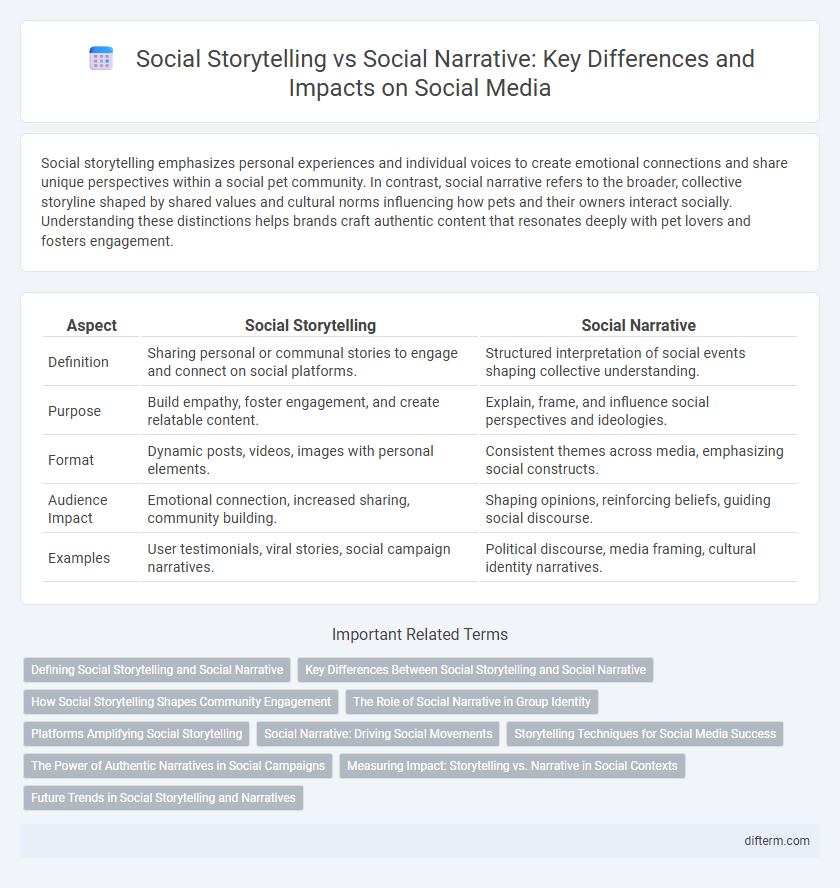Social storytelling emphasizes personal experiences and individual voices to create emotional connections and share unique perspectives within a social pet community. In contrast, social narrative refers to the broader, collective storyline shaped by shared values and cultural norms influencing how pets and their owners interact socially. Understanding these distinctions helps brands craft authentic content that resonates deeply with pet lovers and fosters engagement.
Table of Comparison
| Aspect | Social Storytelling | Social Narrative |
|---|---|---|
| Definition | Sharing personal or communal stories to engage and connect on social platforms. | Structured interpretation of social events shaping collective understanding. |
| Purpose | Build empathy, foster engagement, and create relatable content. | Explain, frame, and influence social perspectives and ideologies. |
| Format | Dynamic posts, videos, images with personal elements. | Consistent themes across media, emphasizing social constructs. |
| Audience Impact | Emotional connection, increased sharing, community building. | Shaping opinions, reinforcing beliefs, guiding social discourse. |
| Examples | User testimonials, viral stories, social campaign narratives. | Political discourse, media framing, cultural identity narratives. |
Defining Social Storytelling and Social Narrative
Social storytelling refers to the active process of sharing and creating stories within a community, emphasizing personal experiences and emotional connections to engage audiences. Social narrative, on the other hand, involves the overarching framework or collective story that shapes a group's identity, values, and cultural norms over time. Understanding these distinctions highlights how storytelling drives immediate interaction while narratives establish long-term social cohesion.
Key Differences Between Social Storytelling and Social Narrative
Social storytelling centers on crafting engaging, relatable tales that evoke emotions and foster connection within communities, emphasizing personal experiences and shared moments. Social narrative, however, refers to the broader framework of societal beliefs, values, and collective identity shaped over time through cultural discourse and media. Key differences include storytelling's focus on individual or group stories that drive emotional engagement versus narrative's role in shaping long-term social ideologies and influencing public perception at a macro level.
How Social Storytelling Shapes Community Engagement
Social storytelling harnesses personal experiences and relatable content to foster emotional connections, boosting community engagement through authentic interactions. By leveraging diverse voices and shared values, it creates a dynamic platform where members feel heard and motivated to participate. This approach contrasts with social narratives, which often frame broader societal issues but may lack the personalized impact needed to drive active community involvement.
The Role of Social Narrative in Group Identity
Social narrative shapes group identity by providing a shared framework of common values, beliefs, and experiences that bind members together. It influences collective memory and social cohesion, reinforcing norms and guiding group behavior through repeated storytelling. This collective narrative empowers communities to maintain continuity and foster solidarity in the face of change.
Platforms Amplifying Social Storytelling
Platforms amplifying social storytelling empower users to share authentic, engaging experiences through multimedia formats such as video, photos, and live streaming. Unlike social narrative, which often constructs broader, collective themes or ideologies, social storytelling emphasizes personal perspectives and emotional connections that resonate on platforms like Instagram, TikTok, and Snapchat. These platforms leverage algorithmic curation and interactive features to boost visibility and foster community engagement around diverse, individual stories.
Social Narrative: Driving Social Movements
Social narrative serves as a powerful catalyst in driving social movements by framing collective experiences and shared values into compelling stories that inspire action. It shapes public perception and mobilizes communities by creating a cohesive understanding of social issues, thereby influencing cultural norms and policy changes. Effective social narratives amplify marginalized voices and foster solidarity, making them essential tools for sustained social change and advocacy.
Storytelling Techniques for Social Media Success
Effective storytelling techniques for social media success include leveraging visual content, authentic voice, and audience engagement to create compelling narratives. Social storytelling emphasizes personal experiences and emotional connections, while social narrative focuses on broader brand messaging and consistent themes. Integrating interactive elements like polls, stories, and user-generated content enhances relatability and drives deeper social media engagement.
The Power of Authentic Narratives in Social Campaigns
Authentic narratives in social campaigns harness genuine experiences and emotions to foster deeper connections and trust among audiences, enhancing engagement and message retention. Unlike generic social storytelling, these narratives amplify marginalized voices and create meaningful social impact by reflecting real community struggles and triumphs. Emphasizing authenticity boosts campaign credibility and drives sustainable change by resonating with individuals' lived realities.
Measuring Impact: Storytelling vs. Narrative in Social Contexts
Measuring impact in social storytelling involves analyzing emotional engagement and immediate audience response through individual stories, while social narrative assessment focuses on long-term cultural shifts and collective meaning within communities. Quantitative metrics such as reach and shares are important for storytelling impact, whereas narrative evaluation emphasizes qualitative changes in societal values and behaviors over time. Both approaches use different methodologies to capture how stories and narratives influence social change at micro and macro levels.
Future Trends in Social Storytelling and Narratives
Future trends in social storytelling emphasize immersive technologies such as augmented reality (AR) and virtual reality (VR), transforming how narratives engage audiences on platforms like Instagram and TikTok. Social narratives are increasingly data-driven, leveraging AI to analyze user emotions and preferences, enabling personalized and interactive content experiences. Emerging tools like AI-powered content generators and blockchain for authenticating stories will redefine trust and creativity in digital social environments.
social storytelling vs social narrative Infographic

 difterm.com
difterm.com